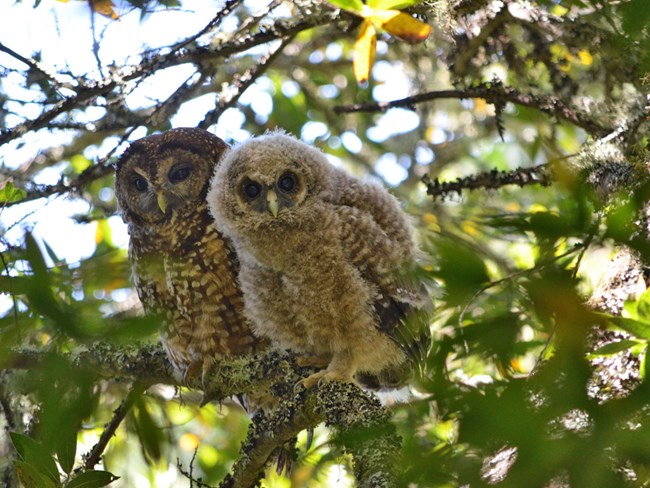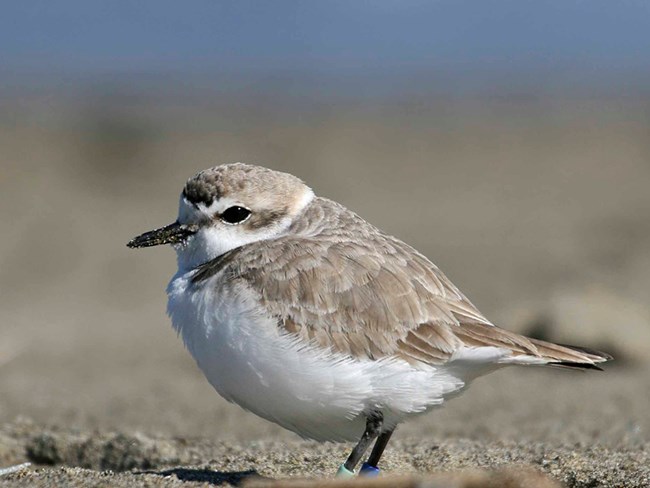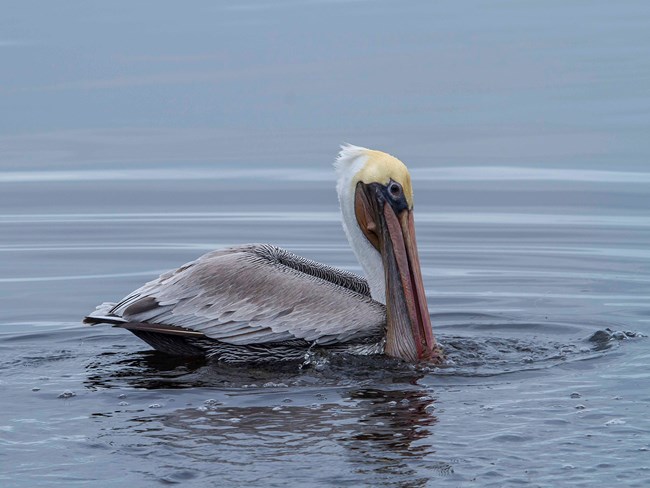
NPS / Jessica Weinberg McClosky 
NPS / Taylor Ellis Northern Spotted OwlThe threatened northern spotted owl was listed in 1990. Northern spotted owls are widely distributed in forested regions from southern British Columbia through Washington, Oregon, and northwestern California. They reach the southern limit of their range in Marin County, where they occur in Golden Gate National Recreation Area, Muir Woods National Monument, Point Reyes National Seashore, and other parts of the county. These three national park units began a joint systematic survey for spotted owls in Marin County in 1993. Preliminary results of these surveys indicate that the county may support the highest density of spotted owls nationwide. Northern spotted owls are typically found in old- and mature second-growth forests, but in Marin County they reside in second- and old-growth Douglas fir, bishop pine, coast redwood, mixed conifer-hardwood, and evergreen hardwood forests. Threats to this species include urban development along protected-area boundaries, intense urban recreational pressures, potential for catastrophic wildfires due to unnatural fuel buildup, possible genetic isolation, and range expansion of the barred owl. Marbled MurreletThe threatened marbled murrelet are found in forest stands with old growth characteristics, and are extremely sensitive to disturbance and noise in the vicinity of nesting areas. A few unverified inland sightings have been reported since 1990. Systematic surveys have been conducted in Muir Woods National Monument and no murrelets have been detected. Marbled murrelets are infrequently seen in nearshore waters from mid-summer through winter. Detection of breeding murrelets in Marin would be extremely significant as there is a geographical gap between breeding populations in San Mateo and Santa Cruz counties to the south, and Mendocino County to the north. Threats to this species include range expansion of ravens, urban development, and urban recreational pressures. Bank SwallowThe threatened bank swallow colony at Fort Funston is the largest nesting colony of bank swallows in the San Francisco Bay Area. Bank swallows migrate from South America to nest in the hundreds of burrows that cover the sandstone cliffs. Watching these aerialists capture insects on the wing and then feed their young while hovering in front of the burrows is a sight to see. Threats to this species include burrow invasions from European starlings, predation by American kestrels, and conflict with recreational uses such as hang gliding and rock climbing. The sandstone bluff is extremely erodible, and intense storm events are also a threat. 
NPS / Will Elder Western Snowy PloverThe threatened western snowy plover was listed in 1993. This small bird over-winters on Ocean Beach and Crissy Field in San Francisco from July through early May. They are here building up energy reserves for mating. Hiding in small depressions in the sand , just beyond the tide line, many visitors who recreate on park beaches never know they are sharing space with the plover. At Crissy Field there is a Wildlife Protection Area for shorebirds near the Gulf of the Farallones visitor center. At Ocean Beach there is a Plover Protection Zone from Sloat Boulevard in the south to Stairwell 21 in the north along the O’Shaughnessey seawall. Threats to this species include recreation such as off-leash dog walking, increased predators such as ravens, intense storm events, and invasive species such as European dune grass. Due to its federal listing status, this species is monitored carefully by park scientists. For more details about plover protections see the Superintendent's Compendium and Exhibits (maps) on the Laws & Policies webpage and the 2008 Special Regulation codified at 36 CFR 7.97(d). 
NPS / Kirke Wrench Conservation Success StoriesDue to collaborative conservation efforts and federal protection from the Endangered Species Act, the following bird species are recovering in the San Francisco Bay Area.California Brown Pelican The California brown pelican has recently been delisted, and is an amazing conservation success story. These birds have been observed roosting at Seal Rocks, Alcatraz Island, Hyde Street Pier, Bird Island, and Kent Island in Bolinas Lagoon. Brown pelicans feed on small fish such as the anchovy along the Pacific coast and in Bolinas and Rodeo lagoons. Threats to this species include boating and active recreation in roosting areas, oil spills, and climatic factors affecting anchovy availability. American Peregrine FalconThanks to conservation efforts protecting the American peregrine falcon, the once-threatened species has been recovering and was de-listed in 1999. The falcons have historically nested at three sites in Golden Gate between the Golden Gate Bridge and Muir Beach since 1990, including Kirby Cove. Peregrines are also known to over‑winter on Bolinas Lagoon. Threats to this species include visitation by fishermen and adventurers, and toxic contaminants. Peregrine falcon decline was linked to the organochlorine pesticide DDT, which thinned egg shells, causing parents to crush their own offspring. DDT was banned in 1972, but other organochlorines still enter the local environment. |
Last updated: January 16, 2025
